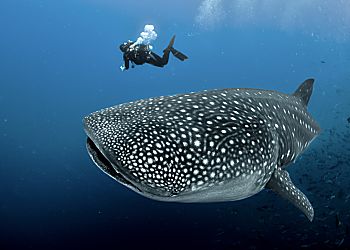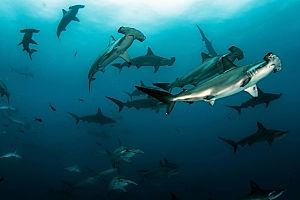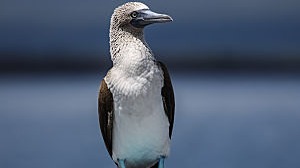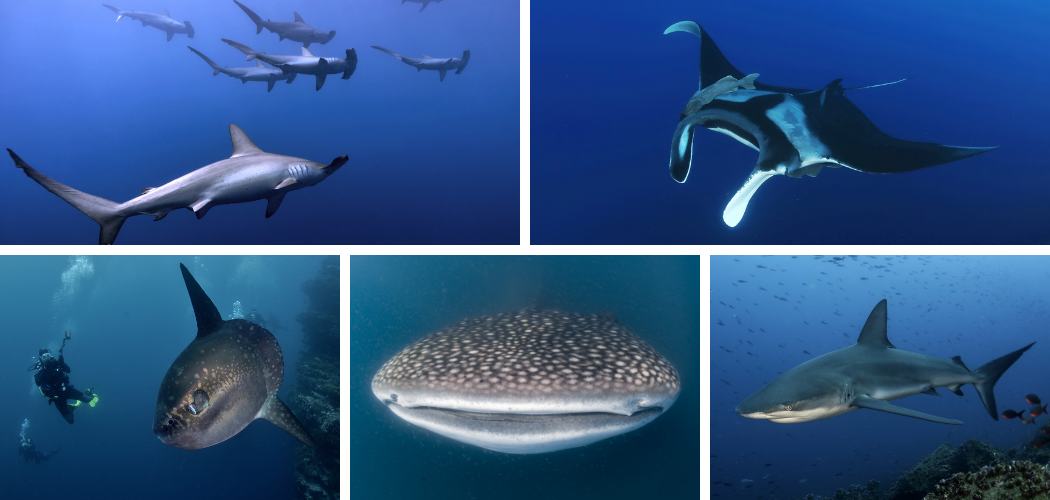 Galapagos never loses its allure. Play with Penguins. Frolic with Sea Lions. Swim with Turtles. Compare your diving skills to those of a giant Whale Shark. Experience the Magic !
Galapagos never loses its allure. Play with Penguins. Frolic with Sea Lions. Swim with Turtles. Compare your diving skills to those of a giant Whale Shark. Experience the Magic !
SCUBA HIGHLIGHTS
It starts with prankish & comical SEA LIONS and sun-loving fur seals … lively, engaging DOLPHINS & adorable Galapagos PENGUINS … then moves to MANTA RAYS, mobula rays, eagle rays & marbled rays … plus gigantic schools of PELAGIC FISH – tuna, jack, snapper & barrcuda. Next come the GALAPAGOS SHARKS, the silkies & black tips, the HAMMERHEADS & WHALE SHARKS … the endemic species such as the RED-LIPPED BAT FISH & Galapagos horn-sharks …. the blue-footed BOOBIES, red-footed boobies, giant tortoises, brown pelicans, frigate birds & FLIGHTLESS CORMORANTS !
DIVE INTO A VORTEX OF CURRENTS & CREATURES
Darwin’s mystical islands are still one of the most miraculous places on the planet. Sitting directly on the equator, these islands happen to be at the vortex of multiple ocean currents which bring varying temperatures and which “swoosh” together waters from varying directions which are densely laced with nutrients – nutrients which support life forms of vastly varying shapes and sizes, from tiny sea horses to the largest fish in the ocean, the magnificent Whale Shark.
There are few divers, in our experience, for whom Galapagos is not amongst their most deeply desired dive destinations … and Darwin and Wolf Islands are two of the most sought-after experiences of world class diving. Diving anywhere in the Galapagos National Park is superb …. but the islands of Darwin and Wolf are just simply unsurpassable.
DARWIN & WOLF …. APEX DIVING … FOR EXPERIENCED DIVERS
The diversity of the pelagics is extreme at these islands, but the immensity of the schools of fish and rays and sharks is certainly what generates that pervading sense of pulsating energy in the water. And, of course, the island’s waters attract whale sharks from July to November when the presence of the Humboldt Current is the strongest. For a more detailed explanation of what you’ll see, read the section below on Darwin and Wolf.
It’s all so invigorating that it’s hard to pull yourself out of the water at the end of a dive.
Let’s be clear about the challenges, though. The currents … and the rough water …. the upwellings and thermaclines .. all require real diving skill. Galapagos is a destination for advanced divers. If you’re not at that level quite yet … get out there and dive, dive, dive … keeping this destination as your goal for the future! It’s well worth striving for ….
DIVE LIVEABOARDS TAKE YOU TO THE ULTIMATE NATURE PARK
There is some land-based diving & a few day boats in the Central Islands … but for serious divers who wish to experience the exhilaration of Darwin & Wolf, your only option is a dive liveaboard. We have chosen the vessels we have full confidence in. They run reliable, safety-conscious, professional diving adventures which we recommend without hesitation.
NATURE CAN BE CAPRICIOUS
Can we also add that the difficulties of currents, upwellings, thermaclines …. are what occur under “normal” conditions? As can happen anywhere in the world, conditions may at times be “unusual” and your experience may be less (or more) than you were anticipating. So, if you read that you’re likely to see hundreds of hammerheads and up to a dozen whale sharks on a trip, we assume you’ll understand that Nature didn’t read the same info that you read.
We trust that whether you see 1 whale shark or 30 …. whether you meet a group of 5 scalloped hammerheads or 5000 …. you’ll count the experience as one of the finest of your life!
YOUR GALAPAGOS ISLANDS DIVING ADVENTURE
{slider  DIVING DARWIN & WOLF … FOR EXPERIENCED DIVERS SEEKING THE ULTIMATE THRILLS
DIVING DARWIN & WOLF … FOR EXPERIENCED DIVERS SEEKING THE ULTIMATE THRILLS
You just have to experience it to understand. You have to be surrounded by the swirling schools of fish. You have to feel the rush of hundreds of massive sharks swimming straight at you … and the whoosh of the current whisking you along. Then you can truly comprehend the enchantment. In the world of diving, we would venture to say that only 2 other destinations hold the same intensity of “charge” as Darwin & Wolf in the Galapagos – and those would be Cocos & Malpelo Islands, the other two points in this formidable Pacific triangle. On your first dive at either Darwin or Wolf, roughly a 12-hour journey north of the Central Islands, you’ll begin to understand what the fuss is all about. … read more …|dest|closed}
First and foremost, in terms of impressions, are the gigantic throngs of hammerhead & scalloped hammerhead sharks – hundreds of individuals in each group. Picture it. Right there. In your face. Sharks and sharks and then more sharks … with stunningly svelte, powerful bodies and simply inconceivable head structures!
Then you notice the manta rays & eagle rays & sea lions, the Galapagos sharks & whitetip sharks & silky sharks, the frolicking bottlenose dolphins … sometimes pilot whales, melon-headed whales … and if you’re there from July through November, the frosting on the cake is the presence of the immense, graceful and captivating whale sharks.
Perhaps due to the sheer overwhelming numbers of sharks and rays in the water around you, you might be tempted to place all your concentration on the “big guys” of the oceans, but really, you won’t want to miss the other delights on offer.
The extent of coral life, surprising to many divers, attracts an unexpected variety of reef fish which add a terrific splash of color to the endless and profound blue of the ocean experience. You get trumpet fish, hogfish, butter¬fly fish & angelfish, grunts, tangs, surgeonfish, snappers, scorpionfish & pufferfish. You find lobsters, countless turtles and a variety of moray eels ….
Then, of course, there are the ever-present dark, moving clouds of jacks, trevallies and barracuda creating the excitement of perpetual motion in the atmosphere.
When you surface, and while you’re on the boat, enjoy the show put on by the bird life – the red-footed boobies & masked boobies, the frigates, the pelicans and the swallow-tailed gulls and keep an eye out for passing whales. Humpbacks, sperm whales and even orcas can be spotted during their migratory passages.
{/sliders} {slider  DIVING THE CENTRAL ISLANDS … FOR FAMILIES & NEWLY CERTIFIED DIVERS
DIVING THE CENTRAL ISLANDS … FOR FAMILIES & NEWLY CERTIFIED DIVERS
You’ll begin and end your Galapagos diving cruise in the Central Islands, so this region will initiate you in the wonders of the archipelago …. and will be your final taste before you regretfully say “adieu”. Above water there will be flightless cormorants, blue footed boobies, possibly red-footed boobies, frigate birds, and the magnificent, absolutely prehistoric-looking brown pelicans. You’ll see the underwater volcanic slopes for the first time and will be introduced to high-spirited sea lions and ubiquitous turtles, fur seals and the weird and wonderful marine iguanas of the Galapagos. The possibility exists that you may catch sight of mobula rays, marble rays, Galapagos sharks, bottle-nosed dolphins, mola-mola & hammerheads. …. read more …|dest|closed}
Certainly there will be barracudas, jacks, snappers, groupers, salema, sting rays & eagle rays … along with the always-entertaining Galapagos penguinsAlmost beyond the shadow of a doubt, you’ll add to your check-list of creatures seen: Galapagos horn sharks, red lipped batfish & creole fish …
Plus it’s rare to exit the water without having seen scorpion fish, frogfish, seahorses, shrimps, slipper lobsters, king angel fish and pufferfish.
It staggers the imagination. And, it’s just the starter course. The main course follows – at Darwin & Wolf.
{/sliders}
This land (and ocean) filled with intriguing species which helped lead Darwin to his theory of evolution, Galapagos is an archipelago of volcanic islands straddling the equator in the Pacific Ocean off the coast of Ecuador. Although located on the equator, the Humboldt Current flows past the islands, bringing cold water to them. The collison of this cold water current with land mass causes frequent drizzles during most of the year. This is of little concern to scuba divers, as far more importantly, the current comes loaded with nutrients which feed the massive throngs of pelagic animals for which Galapagos diving is revered.
